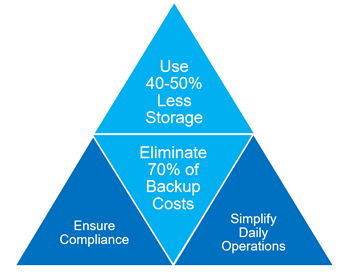Redefining File Services from Edge to Core to Cloud


The idea of running compute and storing data in the cloud is no longer a novel concept. With the evolution of 5G and Internet of Things (IoT), this brings along the next evolution of edge storage demands. Today, around 10% of enterprise-generated data is created and processed outside a traditional centralized data center or cloud. By 2025, Gartner predicts this figure will reach 75%.[1] The types of data generated from the edge locations ranges from office documents, media files, video surveillance to even machine sensor data.

At these edge locations, traditional file storage infrastructures are becoming increasingly difficult to manage due to explosive data growth. Most of those data are residing on traditional file servers with aging architectures that cannot scale beyond petabytes or support the next generation of cloud-based applications. With limited to no IT support in these edge locations, this poses challenges on data security, backup, capacity management and troubleshooting. To exacerbate the situation, many organizations have a workforce in remote offices with the need to enable deep and secure collaboration while ensuring the organization data are protected from malware attacks like ransomware.
In the data centers, legacy file storage solutions do not always work well for cloud applications. The data ingest, access, security and performance required for on premise cloud storage are becoming more significant with customers are looking at a hybrid cloud architecture to leverage the cloud economics. With data residing both at the edge and on the cloud, this raises a need for better data visibility and control to prevent organizations at risk for security and compliance breaches.

Another key challenge faced by business is the continuously growing data sprawled across multiple repositories in a variety of formats. Manually and securely gathering these business data in support of legal requirements can be time-consuming, resource-intensive, expensive, and error-prone. Legal departments often have the need to search through e-mails, instant messages, user documents, vendor applications, and more. Without a streamlined and repeatable way for Legal departments to investigate something, performing regular ad-hoc data discovery tasks can be complicated and require a lot of time, as data sources can be spread across internal, external, third-party locations, and even backup tapes. With ever-increasing regulations, data breaches, and scrutiny placed on businesses today, organizations need a reliable way to handle current and future legal and compliance needs
Solving this file serving problem is the catalyst for moving towards a modern architecture. The IT team needs to be able to deliver file services solutions that go beyond what a traditional NAS can offer. What is needed is a more modern way of governing user data capable of meeting the business’ needs while reducing complexity and costs, and that means leveraging an Object storage. With Object storage, there is no need for traditional backup because it has built-in data protection and self-healing capabilities. This eliminates substantial backup costs and simplify operations. It must be one that scales seamlessly with abilities to extend data protection at the edge locations and end user devices.
 At Hitachi Vantara, we take a holistic approach through our integrated portfolio and growing ISVs eco-system to address the growing requirements. As an on-premise object storage, Hitachi Content Platform (HCP) provides built-in data security and protection, and advanced metadata based allowing you to consolidate dozens of cloud applications through industry standard REST/S3 APIs ensuring the data compliance and long-term retention needs.
At Hitachi Vantara, we take a holistic approach through our integrated portfolio and growing ISVs eco-system to address the growing requirements. As an on-premise object storage, Hitachi Content Platform (HCP) provides built-in data security and protection, and advanced metadata based allowing you to consolidate dozens of cloud applications through industry standard REST/S3 APIs ensuring the data compliance and long-term retention needs.
HCP builds the foundation for your modern file services by connecting your remote and branch offices to HCP through a Storage Gateway that works like traditional NAS from a user and application perspective. It simply functions as a caching device that extends to edge locations such as your branch offices and backup the data to HCP in your data center. As part of digital transformation initiatives, there is also a need to transform how the employee’s work and improves productivity. With HCP Anywhere, it promotes collaboration through secure file sync and share among your users and their mobile devices. The built-in security and immutable capabilities on HCP, along with user self-service file restores helps keep your user from becoming a victim of ransomware attacks. To address the needs for Data Governance and Compliance, Hitachi Content Intelligence provides the data visibility and control with intelligent search capabilities across all your content even if it is in the cloud. This enables early detection of sensitive information such as Personal Identifiable Information (PII) and apply the appropriate action before it becomes a security and compliance issue.
Solving this file serving problem is the catalyst for moving towards a modern architecture. The IT team needs to be able to deliver file services solutions that go beyond what a traditional NAS can offer. What is needed is a more modern way of governing user data capable of meeting the business’ needs while reducing complexity and costs, and that means leveraging an Object storage. With Object storage, there is no need for traditional backup because it has built-in data protection and self-healing capabilities. This eliminates substantial backup costs and simplify operations. It must be one that scales seamlessly with abilities to extend data protection at the edge locations and end user devices.
Today, organizations have evolved beyond just achieving IT centric goals such as storage efficiency, cost, performance. They are looking for business-oriented outcomes by protecting and understanding the data assets they have, improving productivity and time to market. Therefore, Hitachi Content Platform is designed to meet these new requirements delivering both IT and business outcomes from Edge to Core to Cloud for our customers.
Be sure to check out Insights for perspectives on the data-driven world.